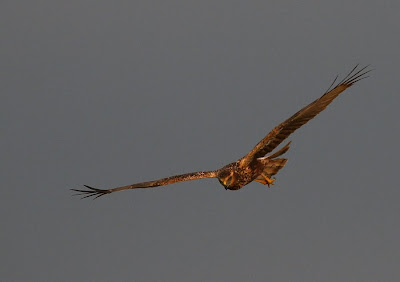Now onto females. These appear even more variable than males!
As with the males, I'll start with the 'easier' ones - the apparent adults - Type 1.
[EDIT: Note from Teruaki Morioka: According to a banding survey of EMHs breeding in Japan, some females in their 10th winter still have dark irides. Though EMHs breeding in Japan have different features from the EMHs breeding in e.g. Manchuria, it is probable that the older females of the latter still have dark irides.]


This is what I identified as a typical adult female. Sexed by the barred tail, aged by the underwing and body feathering, mainly.


Another couple of birds I identified as mature females.

Another presumed adult, though this one has more dense streaking on the head.

This one has rather broad flank streaks and thickly barred axillaries - possibly an indication that this is a 'young adult'. [EDIT: Comment from Teruaki Morioka: This bird is presumably a 3rd winter female. Note the dark secondaries.]

Typical adult female underwing - pale buff underwing coverts with rather fine streaks and whitish, lightly-barred remiges.


This seems to be a near adult female. She still has some chestnut colouration on the thighs - a possible sign that she is not yet fully mature.[EDIT: COmment from Teruaki Morioka: I would age this bird as a 3nd winter female. The iris is pale and not yellow. The secondaries are still dark.]

Type 2. A bird with adult-like remiges but immature wing coverts and body feathers - so perhaps a 3rd winter? [EDIT: Comment from Teruaki Morioka: I agree.]
Type 3. This motley crew are. I think, 2nd winter birds. They are in either wing or tail moult, and the streaking on the head and nape is adult-like.



All the same bird.[EDIT: Comment from Teruaki Morioka: I take this to be a 2nd winter - a female because of the thick tarsi.]




Another bird.[EDIT: Comment from Teruaki Morioka: . I would age this as a 2nd winter. This bird is probably a male because of the thin tarsi and greyish outerwing and the underside of tail.]
Type 4. I take these to be first winter birds. Sexed by lack of grey on uppertail. [EDIT: COmment from Teruaki Morioka: These birds are juveniles/1st winter birds.]



Well - that's my lot for Eastern Marsh-harriers. Next, the less abundant, and therefore less complicated Pied Harriers!
As with the males, I'll start with the 'easier' ones - the apparent adults - Type 1.
[EDIT: Note from Teruaki Morioka: According to a banding survey of EMHs breeding in Japan, some females in their 10th winter still have dark irides. Though EMHs breeding in Japan have different features from the EMHs breeding in e.g. Manchuria, it is probable that the older females of the latter still have dark irides.]


This is what I identified as a typical adult female. Sexed by the barred tail, aged by the underwing and body feathering, mainly.


Another couple of birds I identified as mature females.

Another presumed adult, though this one has more dense streaking on the head.

This one has rather broad flank streaks and thickly barred axillaries - possibly an indication that this is a 'young adult'. [EDIT: Comment from Teruaki Morioka: This bird is presumably a 3rd winter female. Note the dark secondaries.]

Typical adult female underwing - pale buff underwing coverts with rather fine streaks and whitish, lightly-barred remiges.


This seems to be a near adult female. She still has some chestnut colouration on the thighs - a possible sign that she is not yet fully mature.[EDIT: COmment from Teruaki Morioka: I would age this bird as a 3nd winter female. The iris is pale and not yellow. The secondaries are still dark.]

Type 2. A bird with adult-like remiges but immature wing coverts and body feathers - so perhaps a 3rd winter? [EDIT: Comment from Teruaki Morioka: I agree.]
Type 3. This motley crew are. I think, 2nd winter birds. They are in either wing or tail moult, and the streaking on the head and nape is adult-like.



All the same bird.[EDIT: Comment from Teruaki Morioka: I take this to be a 2nd winter - a female because of the thick tarsi.]




Another bird.[EDIT: Comment from Teruaki Morioka: . I would age this as a 2nd winter. This bird is probably a male because of the thin tarsi and greyish outerwing and the underside of tail.]
Type 4. I take these to be first winter birds. Sexed by lack of grey on uppertail. [EDIT: COmment from Teruaki Morioka: These birds are juveniles/1st winter birds.]



Well - that's my lot for Eastern Marsh-harriers. Next, the less abundant, and therefore less complicated Pied Harriers!
1 comment:
Thanks, Dave, a very useful discussion of these. The EMHs that winter in Hong Kong can be described as "motley" too !
Post a Comment